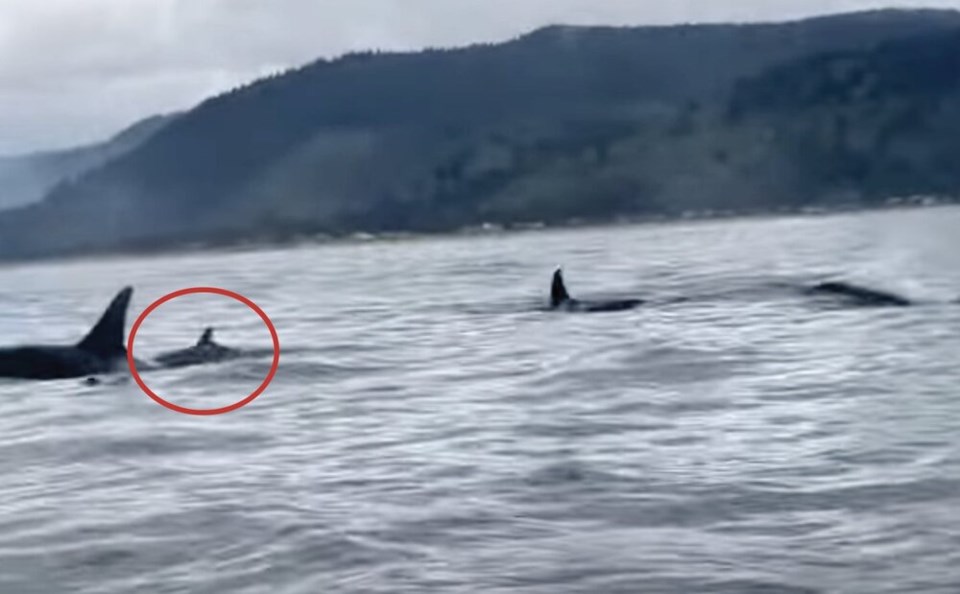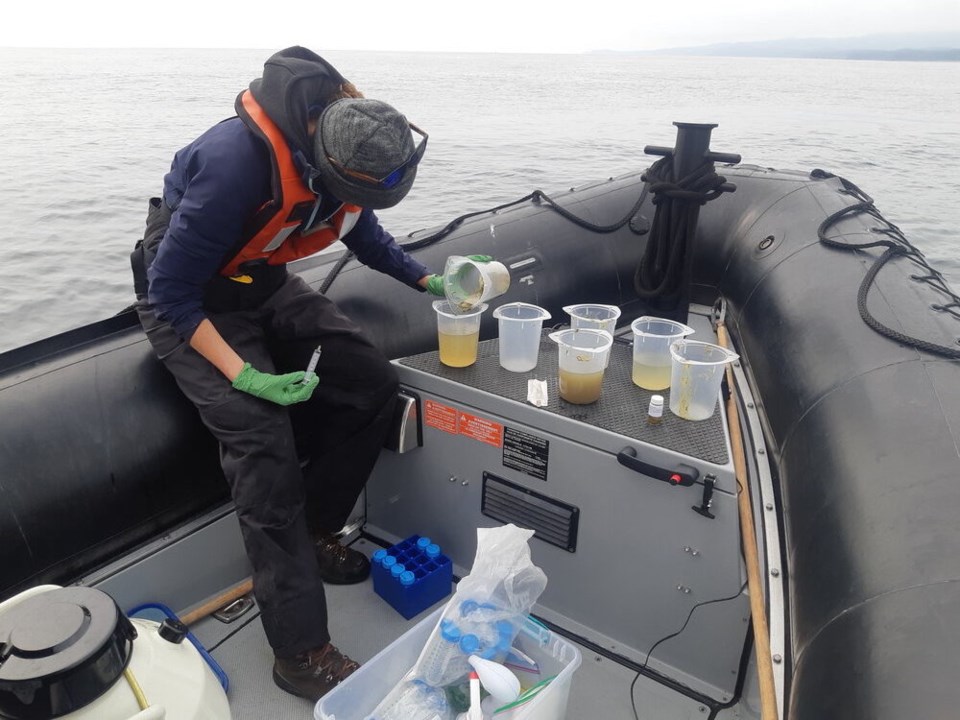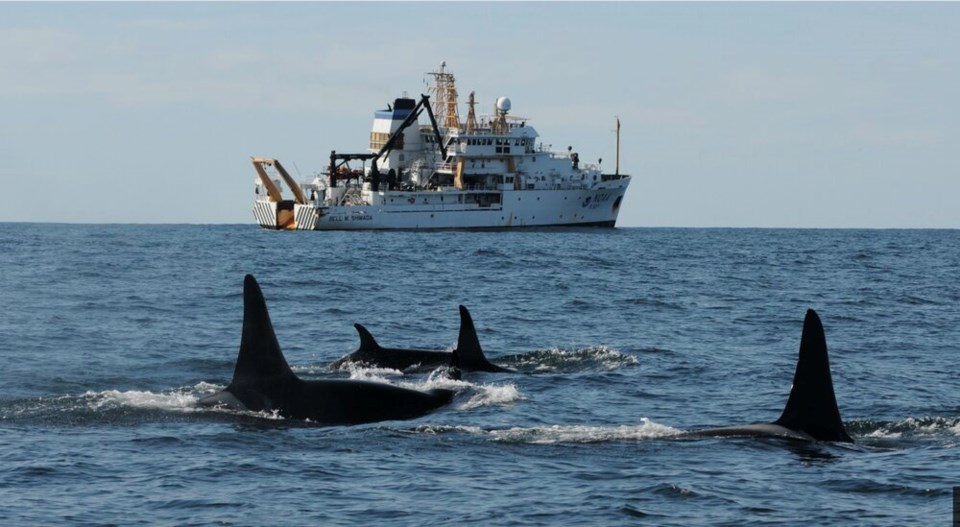An alleged sighting of a new baby orca whale has buoyed hopes for the southern resident killer whale — an endangered species that only days earlier received ramped-up protection measures from Canada's federal government.
The April 28 sighting of what appeared to be a “very young calf” was captured in a video off Pacific City, Ore., confirmed the Center for Whale Research Tuesday.
The small whale appeared to be associating with K20, also known as “Spock.”
If verified, the footage would confirm the first birth in K Pod since 2011.
With 16 confirmed members, K pod is the smallest of the three southern resident killer whale families. Together with J and L pods, the endangered southern resident population peaked at 98 animals in recent decades. But its population has since taken a downward turn, declining to 73 confirmed whales by the end of 2021.
The news prompted whale enthusiasts to light up social media with tempered optimism.
“Cautiously exciting news!” tweeted the group Whale Tales.
“I love you new k pod baby,” wrote an underwater photographer.

Annual measures to protect whales expanded
The news of a potential new calf comes only days after the Canadian government announced it would expand annual measures to protect southern resident killer whales off the shores of British Columbia.
For the fourth year in a row, no vessels — from kayaks to yachts — can come within 400 metres of a killer whale in southern B.C. waters, the federal government announced April 29.
The measure remains in effect until May 31, 2022, and includes a swath of ocean wrapping around the southern end of Vancouver Island, from Campbell River in the Strait of Georgia, up Howe Sound, through the Gulf Islands, into the Juan de Fuca Strait, and up the west coast of Vancouver Island to Ucluelet.
Fisheries and Oceans Canada (DFO) is asking any boater who spots the whales to put their vessel engine in neutral and wait for them to pass.
Sanctuary zones have also been reintroduced off the coasts of Pender and Saturna islands from June 1 until Nov. 30, 2022. Local whale-watching companies, meanwhile, have agreed again to not promote tours featuring southern resident killer whale populations.
A closure protocol for the Southern Gulf Islands commercial and recreational salmon fisheries will once again come into effect — but this time, only once the first southern resident killer whales are seen in the area. Like last year, it will remain in effect until Oct. 31.
In another change this year, fisheries closures will be expanded to a portion of the Swiftsure Bank, along with the Southern Gulf Islands, the Strait of Juan de Fuca and the mouth of the Fraser River.
Two new seasonal slowdown areas will be added near Swiftsure Bank, where all vessels must not exceed a speed of 10 knots between June 1 an Nov. 30, 2022.
The measure, co-developed with Pacheedaht First Nation, comes after years of scientific observations in the waters off the west coast of Vancouver Island.
Should protection measures be year-round?
For some, the federal government’s annual “tweaking” of protection measures for southern resident killer whales doesn’t go far enough.
Christianne Wilhelmson, executive director of the environmental group the Georgia Strait Alliance, said the annual approach to protecting southern resident killer whales fails to fully appreciate that the species is in crisis and needs bolder action.
“There are still areas where the whales will be competing with humans for fish. There are still areas where noise will be an issue,” she said.
“What we need is year-round measures.”
Wilhelmson said year-round no-go zones and fishery closures would also make it easier for ship operators and fishers to navigate the increasingly complicated rules.
“Wouldn't it be easier if these rules were in place 12 months of the year? If people didn't have to figure it out — ‘This year, am I in the right zone? Oh no, I can't put my lure in here. I have to put it over there,’” she said. “That's problematic.”
If the federal government were using “the best science,” Wilhelmson says the federal government would have rolled out far more closures to protect chinook salmon, the whale population’s preferred prey.
Especially, she added, at a time when whale mothers need to be healthy so they can ensure their young are getting enough nutrients to grow and propagate the species.
Federal scientists ‘always playing catch up’
Do this year’s measures to protect southern resident killer whales go far enough?
“It's very difficult for me to say,” said research scientist Sheila Thornton, who leads the marine mammal conservation physiology program at DFO.
Thornton says that’s because her job starts when management asks her team to answer a question. Inevitably, once that question is asked, there’s already a problem.
“We're always playing catch up,” she said.
Thornton has spent the past five years trying to figure out where the southern resident killer whale population prefers to swim and feed — all part of a larger study to measure the impacts of disturbances from shipping, declining food availability and direct competition with recreational and commercial fishers.
So far, there are a lot of questions left unanswered.
One challenge is time. A killer whale generation lasts 20 to 25 years, and tracking five-year fluctuations in behaviour could miss key patterns that play out over 40 years.
One thing they do know: the whales are on the move.
A killer whale exodus, but to where?
The current southern resident population is almost identical to the number of whales left in the wild when live captures were halted in 1974.
Since then, a lot of research on the southern resident population has taken place in the Southern Gulf Islands, where there’s a lot of boat traffic and where the whales were traditionally seen every two days or so throughout the summer.
But that pattern has been disrupted over the last 10 years, says Thornton. The whales are going elsewhere and it’s not clear why.
Acoustic recordings captured by Thornton's DFO predecessor pointed to Swiftsure Bank, where ocean currents meet the outflow of the Juan de Fuca Strait at an undersea wall over 20 kilometres off Vancouver Island. The nutrient-rich waters attract all sorts of the small life salmon like to feed on, and that has made it an important foraging area for southern resident killer whales.
“We have very few eyes on the water out there, but we knew it was a really important area,” said Thornton.
To quantify how important Swiftsure Bank is to the whales and where protective measures needed to be added meant jumping into inflatable Zodiac Hurricane boats in Port Renfrew and motoring out to the off-shore feeding grounds in, at times, heavy swells.
“We would do a visual survey; we would drop the hydrophone and we would listen for the whales,” said Thornton.
When an acoustic signal came in, they would head in that direction, hoping to spot and observe their behaviour, collect samples of prey, and if they got lucky, some whale fecal matter.
“You just keep your eyes open, follow along and have a lot of pool nets handy,” she said.

Thornton says her whale poop specialist is a master’s student who has been on research trips for three years running, an “absolute expert in the texture, smell, quantity, quality and colour.”
Once collected, the samples are flash-frozen in liquid nitrogen at a temperature of -80 Celsius, and later, analyzed to genetically identify which whales they came from.
But finding whales near Swiftsure Bank one season says little about where they'll be next year, and the whales might come back to old foraging grounds when conditions are right.
That’s what makes protecting each tract of preferred critical habitat important, Thornton says. You never know if the abundance of salmon is drawing the whales to other feeding grounds or if some combination of overfishing, pollution and acoustic disturbances from boats has pushed them out for good.
“So it's really a question of are they being pulled out or are they being pushed out?”
As the data comes in, Thornton says it’s still too early to answer that question. Part of the reason is that each pressure on the whale population can lead to more negative outcomes.
Evading ‘death by a thousand cuts’
Where to begin the story of what’s killing the whales is not easy.
Thornton starts with food.
Chinook salmon are already dwindling in the face of habitat destruction, overfishing, disease and the effects of global warming on the sea. A suffering prey population means there are already fewer fish for whales to hunt.
Add noise from shipping traffic, which can effectively blind killer whales by interfering with their ability to echolocate prey, and a whale’s prospect of getting enough fish to survive sinks.
Without enough fish, the whale begins to starve. And when a whale starves, it burns through its fat reserves — the same place where pollution like the banned industrial chemical polychlorinated biphenyls, or PCBs, accumulate.
When the fat burns, those toxins are mobilized, coursing through the whale and often dampening its immune system.
“It’s a very complex, multifactorial death by a thousand cuts, which makes it difficult to manage,” Thornton said.
Balancing competing interests
Part of Thornton’s job is to run the numbers — numbers that will help her team answer questions like, “How many salmon does a single whale need to survive?” Or “Are there enough fish to satisfy whales and fishing boats in a single patch of ocean?”
The answers to those questions inform the annual closures and restrictions.
For example, in a study published last spring, Thornton and her team examined threats from acoustic disturbances and vessel strikes in critical southern resident killer whale habitat.
In some areas, they found the COVID-19 pandemic led to a clear decrease in vessel presence along ferry routes.
They also modelled the acoustic fallout from a projected seven-fold increase in shipping traffic due to the expansion of the Trans Mountain pipeline. Some of the highest modelled increases in the underwater soundscape were found at Swiftsure Bank, the Juan de Fuca Strait and in the waters near Port Renfrew — some of the same areas already facing chronic noise from vessel traffic.
The study was part of a complex body of evidence that led DFO managers to close fisheries and add vessel slow-down measures at Swiftsure Bank.
“There is a precautionary approach that is undertaken with species at risk, especially endangered populations. But of course, the government has to balance the precautionary approach with impacts to stakeholders and find a middle ground,” said Thornton.
That means balancing the interests of the whales against ecotourism businesses, small and big fishers, as well as shipping companies and the region’s ports.
To get all those groups to buy into the restrictions, Thornton says conservation efforts have needed to shift with the seasons.
Meanwhile, Thornton and her team continue on with the science, and will next explore how animals move through the seasons and between day and night.
"We'll be switching over to look at some winter behaviours in the next year,” said Thornton. “It's important when we see a change in habitat preference, to identify if that change is a result of human impacts.”
“We just keep trying to refine it and provide advice as we go along.”




